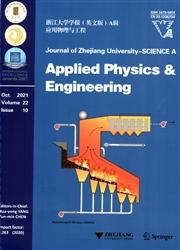Exhaust process of cryogenic nitrogen gas from a cryogenic wind tunnel with an inclined exit
IF 3.9
3区 工程技术
Q1 ENGINEERING, MULTIDISCIPLINARY
引用次数: 0
Abstract
目 的 在使用引射器的基础上, 低温风洞排气系统利用风机和加热器可进一步降低排气羽流的沉降危害, 但也带来了高能耗. 本文旨在探讨排气出口倾斜角度对低温风洞低温氮气排气过程的影响, 并验证采用倾斜排气出口结构对降低低温风洞排气系统能耗的可行性. 创新点 1. 提出低温风洞倾斜出口排气方式; 2. 建立低温风洞排气塔缩比模型, 并开展倾斜出口排气过程的实验分析. 方 法 1. 根据相似性准则, 建立低温风洞排气塔缩比模型, 并通过实验对比倾斜出口排气过程和传统垂直出口排气过程, 验证倾斜出口排气方式是否可降低羽流沉降危害; 2. 通过实验与模拟对比, 验证低温羽流扩散数值模型的准确性; 3. 通过仿真模拟, 进一步量化研究倾斜出口排气方式的节能潜力. 结 论 1. 相比传统垂直排气方式, 30°或45°倾斜出口的排气方式可有效降低低温羽流的沉降危害; 2. 以0.3 m低温风洞极端排气工况为例, 采用30°或45°倾斜出口, 在无风条件下可节省15.9%的加热能耗; 3. 采用倾斜出口排气方式可以提高排气系统的安全下限. A new structural design for the vent stack with an inclined exit was proposed to reduce the settlement hazard of the cryogenic plume from a cryogenic wind tunnel; it extends the plume trajectory to increase the effective contact space and time for mixing between the plume gas and atmospheric air before the plume settles to the ground, contributing to more efficient energy consumption for heating. Reduced-scale experiments and numerical simulations of plume dispersion based on vertical and 30°- and 45°-inclined exits were conducted to study harm reduction and energy-saving potential. Analyses of the minimum temperature and minimum oxygen concentration of the plume near the ground indicate that the new exhaust design with an inclined exit clearly reduces the settlement hazard. Under windless conditions and without using a fan-ejector system, up to 15.9% of the heating energy used by the burner can be saved by adopting the new design.具有倾斜出口的低温风洞中低温氮气的排气过程
目 的 在使用引射器的基础上, 低温风洞排气系统利用风机和加热器可进一步降低排气羽流的沉降危害, 但也带来了高能耗. 本文旨在探讨排气出口倾斜角度对低温风洞低温氮气排气过程的影响, 并验证采用倾斜排气出口结构对降低低温风洞排气系统能耗的可行性. 创新点 1. 提出低温风洞倾斜出口排气方式; 2. 建立低温风洞排气塔缩比模型, 并开展倾斜出口排气过程的实验分析. 方 法 1. 根据相似性准则, 建立低温风洞排气塔缩比模型, 并通过实验对比倾斜出口排气过程和传统垂直出口排气过程, 验证倾斜出口排气方式是否可降低羽流沉降危害; 2. 通过实验与模拟对比, 验证低温羽流扩散数值模型的准确性; 3. 通过仿真模拟, 进一步量化研究倾斜出口排气方式的节能潜力. 结 论 1. 相比传统垂直排气方式, 30°或45°倾斜出口的排气方式可有效降低低温羽流的沉降危害; 2. 以0.3 m低温风洞极端排气工况为例, 采用30°或45°倾斜出口, 在无风条件下可节省15.9%的加热能耗; 3. 采用倾斜出口排气方式可以提高排气系统的安全下限. A new structural design for the vent stack with an inclined exit was proposed to reduce the settlement hazard of the cryogenic plume from a cryogenic wind tunnel; it extends the plume trajectory to increase the effective contact space and time for mixing between the plume gas and atmospheric air before the plume settles to the ground, contributing to more efficient energy consumption for heating. Reduced-scale experiments and numerical simulations of plume dispersion based on vertical and 30°- and 45°-inclined exits were conducted to study harm reduction and energy-saving potential. Analyses of the minimum temperature and minimum oxygen concentration of the plume near the ground indicate that the new exhaust design with an inclined exit clearly reduces the settlement hazard. Under windless conditions and without using a fan-ejector system, up to 15.9% of the heating energy used by the burner can be saved by adopting the new design.
本文章由计算机程序翻译,如有差异,请以英文原文为准。
求助全文
约1分钟内获得全文
求助全文
来源期刊

Journal of Zhejiang University-SCIENCE A
工程技术-工程:综合
CiteScore
5.60
自引率
12.50%
发文量
2964
审稿时长
2.9 months
期刊介绍:
Journal of Zhejiang University SCIENCE A covers research in Applied Physics, Mechanical and Civil Engineering, Environmental Science and Energy, Materials Science and Chemical Engineering, etc.
 求助内容:
求助内容: 应助结果提醒方式:
应助结果提醒方式:


